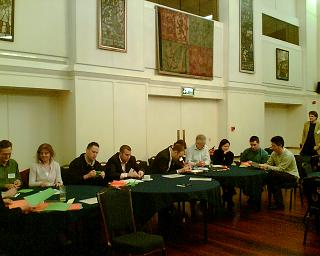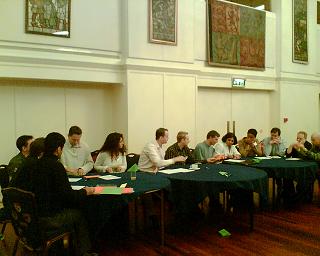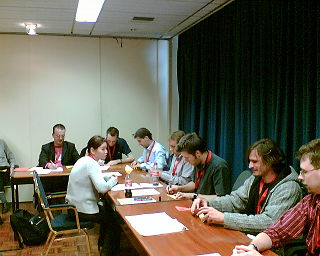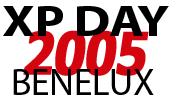|
|

I will be presenting the Toyota Way session at the French XP Days in Paris, on 23 and 24 March.
This session will describe the 14 management principles and how they can be (and have been) applied to software development management.
I’ll be using a new presentation style, following some tips I got from Presentation Zen (link by Nico). The slides contain a lot less information (well, almost none), but they are cues to underline the story of the presentation. It’s a combination of the “Takahashi method” (but not so sparse) and the “Lessig method” (but not so rapid-fire).
I’ve already used this presentation technique once, together with Vera Peeters, to present “The Origins of Agile”. I thought it was fun, fast and contained some useful information. Come and see for yourself in Paris.
Tags: agile, lean, Toyota Way, XP Day
 Rob Westgeest and I ran the I’m not a Bottleneck! I’m a Free Man! session on the “Theory of Constraint’s 5 focusing steps” at XP Day London. Rob Westgeest and I ran the I’m not a Bottleneck! I’m a Free Man! session on the “Theory of Constraint’s 5 focusing steps” at XP Day London.
We had rather a large group, so instead of the usual 7, we played the session simulation with 14 people or 7 pairs.
You can see the first run of the simulation on the left. Notice how
- some people are very busy, most notably the two people in the middle who have to fold the boats. Half finished work starts to pile up in front of them.
- some people are idle and look a bit bored, like the people at the end of the production line. They only receive some work once in a while, most of the time they’re waiting for input.
As per the simulation’s design, the ‘programmers’ in the middle of the team are the bottlenecks. Our first round programmers didn’t seem to be very happy about that.
 Rob and I then introduced the “5 focusing steps” to optimize the system. We chose one of the optimization steps and ran the simulation again with 14 other people. This let everybody experience the simulation and avoided the “elevation by experience” effect. Rob and I then introduced the “5 focusing steps” to optimize the system. We chose one of the optimization steps and ran the simulation again with 14 other people. This let everybody experience the simulation and avoided the “elevation by experience” effect.
This time, the team produced one more boat/hat pair (their primary goal) and consumed a lot less paper (their secondary goal). As expected.
But we also saw some unexpected stuff happening. This time round, all of the player roles were idle some of the time. In a system with a bottleneck, we expect the bottleneck never to be idle, because every bit of work wasted at the bottleneck is wasted work for the whole system. Why did this happen? Maybe the players in front of the new bottleneck (design, just in front the programmers), over-optimized the second goal (don’t waste paper) at the expense of the primary goal (fold more paper boats and hats). By doing this they “starved” the bottleneck.
We had some more discussion of the 5 focusing steps. Usually we do this first part in one hour. At XP Day London we had 90 minutes. Instead of stopping when the material ran out, we continued, trying to fill the extra 30 minutes with some extra material on Throughput Accounting. That was a mistake, because the participants (and presenters) got very low on energy. We should have listened better to Tim Lister’s keynote where he wondered why projects never finish early…
In the second part, 4 volunteers played “customers” who wanted some help with their process. The other participants played newly graduated “Theory of Constraints consultants” who wanted to make a lot of money help their customer.
Some observations:
- most “customers” felt that their “consultants” had really helped them to see their situation and options more clearly.
- I thought most of the “consultants” really had trouble following the focusing steps “slowly”, but wanted to jump ahead to the solution before understanding the problem. I have this problem too. That’s why I use the 5 focusing steps: they force me to slow down and think carefully.
- One customer said that the goal of his system was to “implement “. It’s not uncommon in “real life” that customers bring in a consultant to “just implement my solution”.
Programmers often complain that “customers don’t know what they want“. For consultants, a customer “who knows what they want” is the most dangerous kind. Whatever you do, never implement this solution, unless you’ve made sure that it really is a good solution for the worst problem the customer has. If someone asks you to implement a solution, ask them first “If that’s the solution, what’s the problem?”
Simon Baker has written a blog entry about the session
 Marc Evers and I hosted a talk and workshop on the “Toyota Way” at XP Day Germany 2005. Marc Evers and I hosted a talk and workshop on the “Toyota Way” at XP Day Germany 2005.
The session contained two parts. In the first part we gave an overview of the 14 principles outlined in the book. In the second part, participants were asked to tell which principles they had experienced. For each principle, they had to tell a short story to the other participants in their working group. Their experience could be positive or negative, indicated by putting a green or red sticker on the card that represented the principle.
Here’s the tally of experiences that we collected:
| Principle |
Green |
Red |
| Base your management decisions on a long-term philosophy, even at the expense of short-term financial goals |
|
1 |
| Create continuous process flow to bring problems to the surface |
3 |
|
| Use “Pull” systems to avoid overproduction |
|
|
| Level out the load (Heijunka) |
1 |
|
| Build a culture of stopping to fix problems, to get quality right the first time |
2 |
|
| Standardized tasks are the foundation for continuous improvement and employee empowerment |
2 |
|
| Use visual control so no problems are hidden |
4 |
|
| Use only reliable, thoroughly tested technology that serves your people and process |
|
1 |
| Grow leaders who thoroughly understand the work, live the philosophy and teach it to others |
|
|
| Develop exceptional people and teams who follow your company’s philosophy |
|
|
| Respect your extended network of partners and suppliers by challenging them and helping them improve |
2 |
|
| Go and see for yourself to thoroughly understand the situation (Genchi Genbutsu) |
4 |
|
| Make decisions slowly by consensus, thoroughly considering all options; implement decisions rapidly |
2 |
|
| Become a learning organisation through relentless reflection (Hansei) and continuous improvement (Kaizen) |
2 |
|
What can we learn from this very summary overview?
- Many people recognized the principles. There are only three principles without examples. Interestingly, there’s no example of the “people” processes to develop exceptional leaders and teams.
- Most of the stories got green stickers. Participants found these principles useful. Or maybe they prefer to tell positive stories.
- Two principles got a red sticker: the “long term philosophy” and “use only reliable technology” principles. We didn’t have the time at the session to go into the stories, but I’d love to hear the story behind those. If the participants who told those two red stories would like to share them, let me know.
I enjoyed the session. We got lots of questions and debate during the presentation. Some people even called my implementation of some of these principles “extreme” 🙂
I’m particularly happy that the participants recognized these principles in their own work. We can all use management techniques, because we’re all managers, even if some of us only manage ourselves.
Update 11/12/2005: Andreas Zwinkau blogs about the session (in German).
 Theory of Constraints @ XP Day Benelux Theory of Constraints @ XP Day Benelux
Rob Westgeest and I ran the I’m not a Bottleneck! I’m a free man! session at XP Days Benelux 2005. I ran this session with Marc Evers at the XP2005 conference before. You can read more about that session on my site.
The first part of the session is a simulation of a production line, where participants have to fold and decorate hats and boats. The picture on the left shows the participants re-running the simulation after “elevating the constraint” by adding another person (Nathalie on the left) to help Vincent, who was the bottleneck in the first round. This had the effect of increasing the team’s output. Some of that increase can also be attributed to the fact that by the second simulation, the participants have more practice.
Elevating the constraint also had the effect of shifting the bottleneck away from folding the boats and hats, towards the next step: decorating hats and boats. That’s quite likely if you perform a large intervention like elevating the constraint by doubling the manpower.
In the second part of the session the participants, newly graduated “Theory of Constraints consultants”, had to solve some real-world problems. Erik, Marko and Nathalie acted as customers. The others played consultants who tried to help their customers by discovering the system, the goal and the bottleneck and applying the “5 focusing steps“.
What amazes me is that each time we ran this session, participants were able to understand their customer’s situation and propose 3 possible optimizations. Within less than an hour! And after only one hour of schooling. If you want to optimize your process, hire these people!
That tells me that the 5 focusing steps are both easy to understand and apply. These steps might look trivial, but they give you focus. And these steps are not as easy as they sound. Just try to find out what the goal of your organisation is…
We’ll be hosting this session at the XP Days London 2005 conference, next Monday. If you want to improve your process, join us there.
 I’m again organizing XP Day Benelux with Vera, Marc and Rob. This year we’re back in the Netherlands, in Rotterdam. I’m again organizing XP Day Benelux with Vera, Marc and Rob. This year we’re back in the Netherlands, in Rotterdam.
It’s the third time we organize this event and it keeps getting bigger. This year is the first time we have two conference days. This brings with it some extra work (e.g. people need to stay overnight), but the growth and extra work is still manageable with the help of Marko, Willem, Nynke, Erik and Peter. We already have experience with two day events, because the Agile Open conference started out as a two day conference.
The conference will be held on November 17th and 18th, only a month from now. Still a lot of work to do, but things seem to go smoothly (for now…). I’m currently mostly working on handling the registrations, invoicing, payments. We have a little application to help us with that and I’ll tell a bit more about it later.
I’m also co-presenting two sessions at the conference:
And that’s not all… November is “conference month” for me:
 I’ll be going to the German XP Days on November 21st in Karlsruhe. My boss (me 🙂 won’t let me go to such conferences unless I present a session, so that’s what I’ll be doing. I’ll be hosting a session on The Toyota Way, similar to the session I hosted at the XP2005 conference in Sheffield this year. I’ll be going to the German XP Days on November 21st in Karlsruhe. My boss (me 🙂 won’t let me go to such conferences unless I present a session, so that’s what I’ll be doing. I’ll be hosting a session on The Toyota Way, similar to the session I hosted at the XP2005 conference in Sheffield this year.
 And I’m also going to XP Day London on November 28th and 29th. The London XP Day inspired us to do something like that ourselves. I will be hosting the I’m not a bottleneck! I’m a free man! with Rob Westgeest. And I’m also going to XP Day London on November 28th and 29th. The London XP Day inspired us to do something like that ourselves. I will be hosting the I’m not a bottleneck! I’m a free man! with Rob Westgeest.
There’s a lot of cooperation and exchange of ideas between the different XP Days. And soon we’ll have XP Day France!
See you at one of these fine events!
|



 Rob and I then introduced the “
Rob and I then introduced the “ Theory of Constraints @ XP Day Benelux
Theory of Constraints @ XP Day Benelux I’m again organizing XP Day Benelux with
I’m again organizing XP Day Benelux with 
